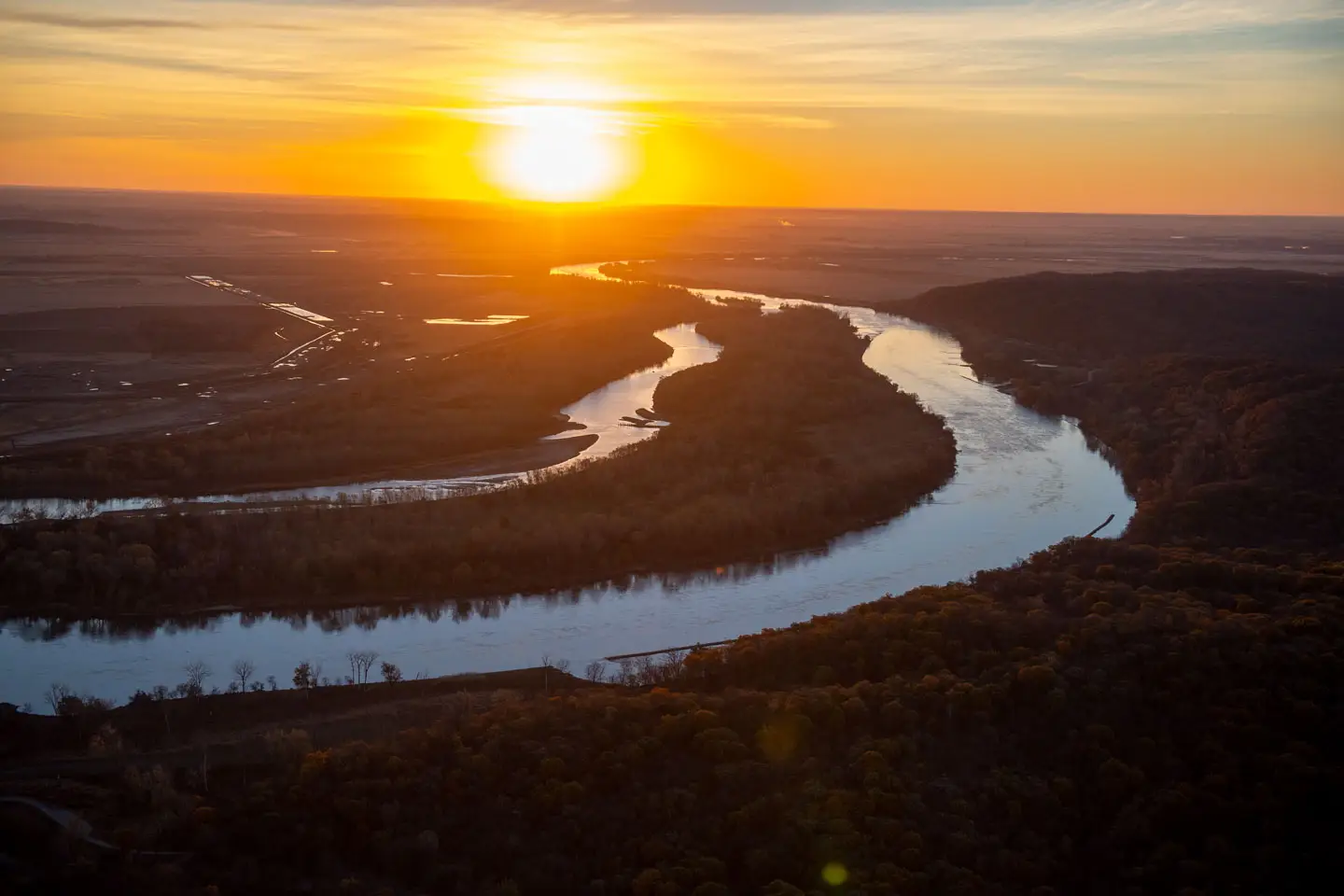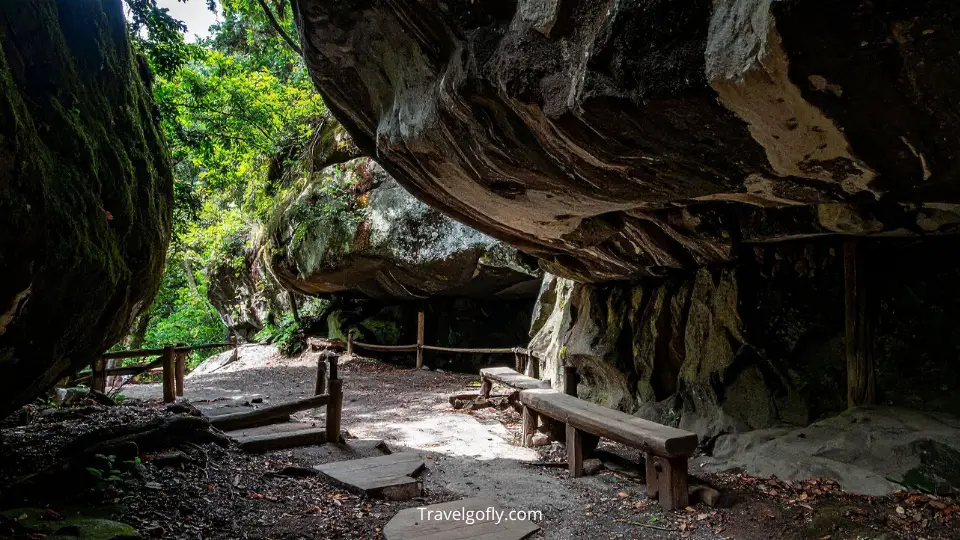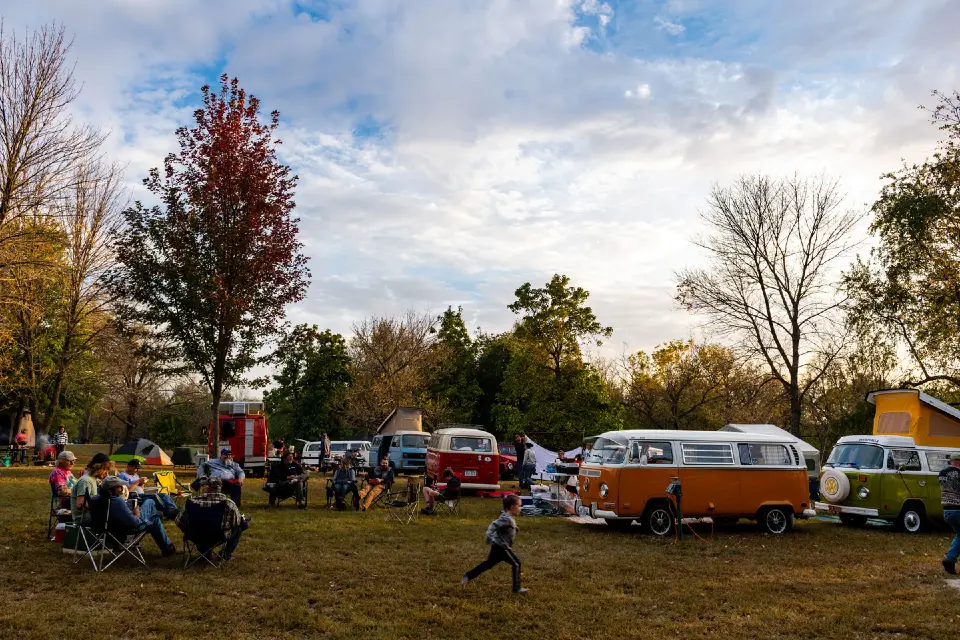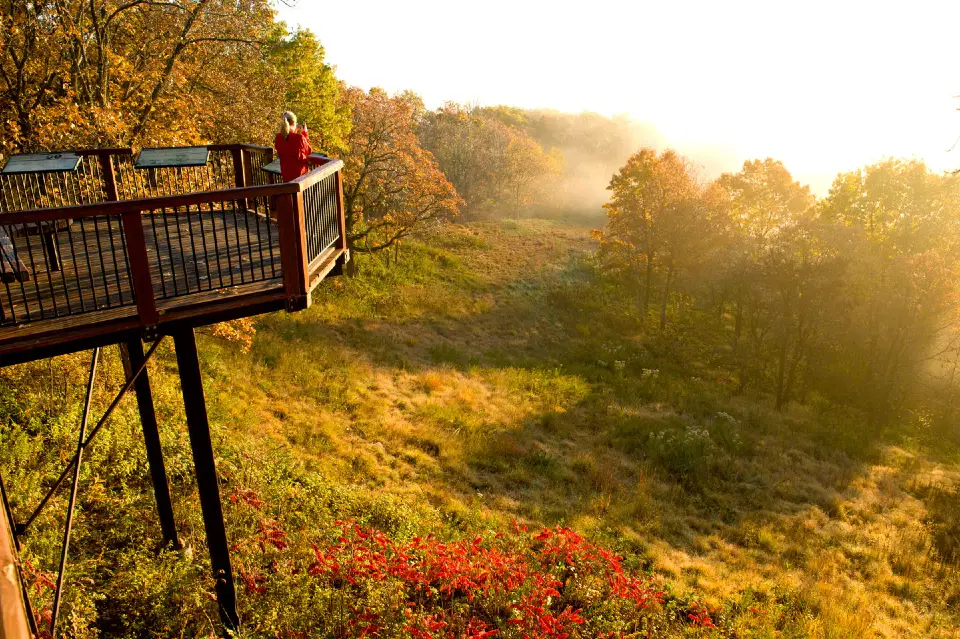Indian Cave State Park is one of Nebraska’s most remarkable destinations, blending prehistoric history with breathtaking natural beauty. Spanning 3,400 acres along the Missouri River, Indian Cave State Park Nebraska stands out for its massive sandstone cave covered in ancient petroglyphs, offering visitors a rare glimpse into the past. Beyond its history, the park delivers unforgettable outdoor experiences with miles of scenic hiking trails, diverse wildlife, and panoramic views that rival the landscapes of Colorado or Arkansas. Often called Nebraska’s Ozarks, Indian Cave State Park is the perfect place for anyone seeking adventure, culture, and nature all in one stunning location.
Whether you’re seeking family-friendly hiking trails, peaceful camping under towering hardwoods, or a glimpse into America’s ancient past through Native American rock art, this hidden gem delivers experiences that will leave you planning your return visit before you’ve even left.

Getting to Indian Cave State Park Nebraska: Best Routes & Travel Tips
Getting to Indian Cave State Park NE is easier than you might expect, despite its secluded feel once you arrive. Located in the far southeast corner of Nebraska near the Kansas border, the park sits approximately 10 miles south of the historic river town of Brownville.
From Omaha (about 1.5 hours): Take Highway 75 south through Nebraska City, continue to Brownville, then follow Highway 67 south to Shubert. Turn east on County Road S64E and follow signs for 5 miles to the park entrance.
From Kansas City (2 hours): Drive north on I-29 through Missouri, cross into Iowa, then take Highway 2 west into Nebraska. Connect with Highway 67 north through Auburn to Shubert, then head east on S64E.
From Lincoln (2 hours): Take Highway 2 east through Palmyra and Nebraska City, then south on Highway 75 to Brownville before following the Shubert route.
The park’s address is 65296 720th Road, Shubert, NE 68776. GPS coordinates work well, but cell service can be spotty in the deeper valleys, so download offline maps before your arrival. The nearest fuel and major supplies are in Auburn (15 miles) or Nebraska City (25 miles), so plan accordingly.
Public transportation doesn’t serve this remote area, making a personal vehicle essential. The park roads are well-maintained gravel and suitable for RVs up to 40 feet, though some camping loops have tighter turns.
Indian Cave State Park History: From Ancient Petroglyphs to Pioneer Days
The story of Indian Cave State Park spans thousands of years, beginning with the Native American tribes who first carved symbols into the soft sandstone cave walls. These petroglyphs, created by various Plains tribes over centuries, depict animals, human figures, and mysterious symbols whose meanings continue to intrigue archaeologists and visitors alike.
The cave itself formed over millions of years as the Missouri River carved through limestone and sandstone bluffs. Native Americans used this natural shelter as a waypoint along river travel routes, leaving behind not just artwork but evidence of seasonal camps and tool-making sites scattered throughout the park.
European settlement brought dramatic change in the 1850s when German and French immigrants established the river town of St. Deroin near the present-day park boundary. This bustling steamboat port grew to over 1,000 residents before the railroad’s arrival shifted commerce away from river transport. Today, visitors can explore the reconstructed St. Deroin village, complete with a one-room schoolhouse, general store, and the original cemetery where pioneer families rest beneath weathered headstones.
The Missouri River itself played a crucial role in American expansion, serving as the highway for Lewis and Clark’s Corps of Discovery in 1804. While they didn’t specifically document the cave, their journey passed near this very shoreline, making the park a tangible connection to America’s westward exploration.
Nebraska acquired the land for the state park in the 1960s, preserving both the natural ecosystem and historical sites that might otherwise have been lost to development. The Civilian Conservation Corps influence is still visible in some of the park’s original stone and timber structures, built with the craftsmanship that defined Depression-era public works projects.

Things to Do at Indian Cave State Park: Hiking, Camping & More
Indian Cave State Park trails offer 22 miles of diverse hiking experiences that showcase why this park feels so different from the rest of Nebraska. The terrain varies dramatically from river bottom forests to prairie ridgetops, with elevation changes that challenge your legs and reward you with spectacular views.
Hiking and Nature Exploration
The Cave Trail is the park’s crown jewel – a moderate 1.5-mile loop that leads directly to the famous petroglyphs. The path winds through dense hardwood forests of oak, hickory, and walnut trees before ascending to the cave opening about 100 feet above the Missouri River. Rangers often lead guided tours that explain the petroglyphs’ significance and point out details easily missed by casual observers.
The Scout Trail provides the park’s most challenging hike, climbing steeply to scenic overlooks that reveal the Missouri River valley stretching into Iowa and Missouri. During fall, this 3-mile round trip becomes a photographer’s paradise as the hardwood canopy explodes in brilliant reds, oranges, and golds.
For families with younger children, the Woodduck Trail meanders through bottomland forests and prairie edges, offering excellent wildlife viewing opportunities. Early morning hikers frequently spot deer, wild turkeys, and the occasional fox along this easy 2-mile loop.
Camping Adventures
Indian Cave State Park camping caters to everyone from RV enthusiasts to wilderness backpackers. The main Indian Cave State Park campground features 134 sites spread across several loops, each with its own character and amenities.
Electric Plus sites offer 50-amp hookups, water, and sewer connections – perfect for large RVs and extended stays. Electric sites provide 30-amp power and access to modern restrooms with hot showers. Basic sites appeal to tent campers and those seeking a more rustic experience while still having access to facilities.
The horse camping area accommodates equestrian visitors with 16 miles of dedicated riding trails winding through forests and prairies. These trails are closed to hikers, ensuring a peaceful experience for both horses and riders.
For true adventurers, backcountry camping is allowed throughout the park with proper registration. Adirondack shelters positioned along remote trails provide basic protection from weather while maintaining that wilderness connection.
Water Activities and Fishing
The Missouri River provides excellent fishing opportunities for catfish, bass, and seasonal species. The park maintains several river access points, though the current can be deceptively strong – always exercise caution near the water.
Canoeing and kayaking are popular during spring high water, but the Missouri’s unpredictable nature requires experience and proper safety equipment. Local outfitters in nearby Brownville can provide boats and shuttles for those wanting guided river experiences.
| Trail Name | Distance | Difficulty | Highlights |
|---|---|---|---|
| Cave Trail | 1.5 miles | Moderate | Petroglyphs, forest views |
| Scout Trail | 3.0 miles | Challenging | River overlooks, fall colors |
| Woodduck Trail | 2.0 miles | Easy | Wildlife viewing, family-friendly |
| Equestrian Trails | 16 miles | Varies | Horse-only, multiple loops |
Indian Cave State Park Campgrounds & Lodging Nearby
Indian Cave State Park Nebraska camping offers some of the most scenic campsites in the Midwest, but the experience varies significantly depending on which area you choose. Understanding these differences helps ensure your visit matches your expectations and comfort preferences.
Campground Options and Amenities
The Electric Plus sites (Sites 1-25) occupy the most desirable locations with full hookups and easy access to the shower house and camp store. These level, gravel pads accommodate large RVs comfortably, with most sites offering partial shade from mature oak trees. Advance reservations are essential during peak seasons, especially for weekend stays.
Electric sites (Sites 26-78) provide a middle ground between convenience and nature immersion. These sites feature 30-amp power and access to clean restrooms, but you’ll need to fill water tanks and use the dump station. Many of these sites back up to wooded areas, providing more privacy than the premium locations.
Basic sites (Sites 79-134) appeal to tent campers and those seeking a more rustic experience. Available year-round, these sites rely on central water spigots and vault toilets, but the trade-off comes in spectacular locations closer to hiking trail access and deeper forest settings.
The park’s shower facilities are notably clean and well-maintained, featuring hot water and adequate space even during busy periods. A coin-operated laundry facility handles longer stays, while the dump station accommodates both RVs and portable waste tanks.
Nearby Lodging Alternatives
For those preferring hotels near Indian Cave State Park, options require a bit of travel but offer comfortable alternatives. Auburn (15 miles north) provides the closest accommodations with several chain hotels and local motels. Nebraska City (25 miles) offers more diverse lodging options, including historic bed-and-breakfasts and modern hotels with amenities like pools and complimentary breakfast.
The Arbor Day Farm Lodge in Nebraska City deserves special mention for families combining their park visit with other regional attractions. This eco-friendly lodge provides comfortable accommodations while maintaining a nature-focused theme that complements the park experience.
Brownville (10 miles) offers charming bed-and-breakfast options in historic homes, though availability is limited and reservations well in advance are recommended.

Visitor Guide: Indian Cave State Park Fees, Permits & Facilities
Indian Cave State Park operates year-round, though facilities and accessibility vary by season. Day-use visitors can explore from sunrise to sunset, while campers enjoy 24-hour access to their sites and basic facilities.
Entry Fees and Permits
A valid Nebraska Park Entry Permit is required for all visitors. Daily permits cost $5 per vehicle, while annual Nebraska Park Permits ($30) provide excellent value for frequent visitors or those exploring multiple state parks. These permits are available at the park office, through the Iron Ranger self-service stations, or online through the Nebraska Game and Parks Commission website.
Camping Fees and Reservations
Camping fees vary by site type and season. Electric Plus sites range from $25-35 per night, Electric sites cost $20-25, and Basic sites run $15-20. If arriving after hours, campers register their nightly camping fees in a raised locked box called an Iron Ranger using cash or checks only.
Reservations are strongly recommended for weekends and peak seasons (April through October). The ReserveAmerica system handles bookings up to 5 months in advance, with a small booking fee added to camping charges.
Park Facilities and Services
The park office, located near the main campground, stocks basic supplies, firewood, ice, and Nebraska Parks merchandise. Staff members provide maps, trail conditions, and recommendations for current wildlife viewing opportunities.
Modern restrooms with flush toilets and sinks serve the main camping areas, while vault toilets serve remote areas and trailheads. Showers are available in the Basic camping area, as well as a water hydrant and electrical hookups for those needing to top off supplies.
Picnic areas with tables and grills dot the park, including several group picnic shelters available for reservation. The largest shelter accommodates up to 100 people and includes electricity and nearby restroom access.
Rules and Regulations
Standard state park rules apply, including leash requirements for pets, quiet hours from 10 PM to 6 AM, and campfire restrictions during dry conditions. Glass containers are prohibited in swimming areas, though the Missouri River’s current and conditions rarely make swimming advisable.
Hunting is allowed in designated areas during established seasons with proper licenses. Fishing requires a valid Nebraska fishing license for anyone 16 and older.
Insider Tips: Best Time to Visit Indian Cave State Park
Having guided countless visitors through Indian Cave State Park over the years, I’ve learned which strategies separate good visits from truly memorable ones. These local insights can transform your experience from ordinary to extraordinary.
Best Times to Visit
Spring (April-May) offers wildflower displays and migrating bird activity, but trails can be muddy after heavy rains. The petroglyphs are easiest to photograph during spring’s softer light, before summer’s harsh shadows obscure details.
Fall (September-October) provides the park’s most spectacular scenery as hardwood forests display peak colors. Weekend camping fills quickly during October, so book early or consider weekday visits for smaller crowds and better wildlife viewing.
Winter camping appeals to hardy souls seeking solitude, but water systems may be shut off and some facilities closed. However, the park is open year-round, but some facilities may have limited hours during the winter months, and snow-covered trails offer a completely different perspective of the landscape.
What to Pack
Beyond standard camping gear, consider bringing a good flashlight or headlamp for cave exploration – the petroglyphs are easier to see with angled lighting. Insect repellent is essential during warm months, as Missouri River bottomlands breed mosquitoes and ticks.
Sturdy hiking boots prove invaluable on rocky, root-covered trails that can be slippery when wet. A camera with macro capabilities helps capture petroglyph details and wildflower closeups.
Water bottles are crucial – while the park has water sources, carrying your own ensures you stay hydrated on longer hikes without having to backtrack.
Hidden Gems and Secret Spots
The cemetery overlook rarely appears on maps but offers one of the park’s best sunset views. From the St. Deroin cemetery, follow the unmarked path west for 200 yards to a small clearing above the river bend.
Early morning wildlife watching is most productive along the Woodduck Trail between 6:30-8:00 AM. Deer, wild turkeys, and various bird species are most active before human foot traffic increases.
The Missouri River access point near the horse trail parking offers excellent fishing and solitude, but requires a steep quarter-mile walk down to the water. Most visitors never discover this spot, making it perfect for contemplative river time.

FAQ: Everything You Need to Know About Indian Cave State Park Nebraska
Q: Can you actually go inside the Indian Cave and see the petroglyphs?
A: Yes! The cave is accessible via the Cave Trail, and visitors can enter to view the prehistoric petroglyphs carved into the sandstone walls. Guided tours of Indian Cave are available and are highly recommended to learn about the symbols’ significance and historical context.
Q: Is Indian Cave State Park good for RVs and large motorhomes?
A: Absolutely. The park accommodates RVs up to 40 feet with full hookup sites available. The main campground roads are well-maintained gravel, and many sites are level with adequate maneuvering room. However, some loops have tighter turns, so check with park staff about the best sites for your rig size.
Q: What’s the best trail for families with young children?
A: The Woodduck Trail is perfect for families, offering an easy 2-mile loop through diverse habitats with excellent wildlife viewing opportunities. The path is well-maintained with minimal elevation gain, and interpretive signs help engage children with nature education.
Q: Can you swim in the Missouri River at the park?
A: While swimming isn’t prohibited, the Missouri River has strong, unpredictable currents that make it dangerous for swimming. The park doesn’t maintain designated swimming areas, and the muddy river bottom and swift current present significant risks.
Q: Are there showers and modern restrooms for tent campers?
A: Yes, showers are available in the Basic camping area along with modern restrooms. Even tent campers in the most rustic sites have access to clean facilities with hot water, making the park comfortable for all camping preferences.
Q: When is the best time to see fall colors at Indian Cave State Park?
A: Peak fall colors typically occur during the first three weeks of October, with timing varying slightly based on weather conditions. The diverse hardwood forest creates a spectacular display of reds, oranges, and golds that rivals more famous fall destinations.
Plan Your Adventure: Why Indian Cave State Park Belongs on Your Bucket List
Indian Cave State Park proves that Nebraska holds natural treasures capable of surprising even seasoned outdoor enthusiasts. This remarkable destination combines prehistoric history, diverse ecosystems, and outdoor adventures in a setting that feels more like Arkansas or Colorado than the Great Plains.
Whether you’re drawn by the ancient petroglyphs, challenging hiking trails, peaceful camping among towering hardwoods, or simply the chance to experience Nebraska’s most unique landscape, this hidden gem delivers experiences that create lasting memories.
The park’s blend of accessibility and wilderness character makes it perfect for introducing children to nature, challenging experienced hikers, or providing couples with a romantic retreat along one of America’s most historic rivers. With 22 miles of trails, multiple camping options, and year-round access, Indian Cave State Park Nebraska offers enough variety to warrant multiple visits throughout the seasons.
Start planning your visit today by checking availability through the Nebraska State Parks reservation system, and don’t forget to explore our comprehensive guides to other hidden gems throughout the state park system. Your adventure in Nebraska’s “Ozarks” awaits!
Have you discovered the magic of Indian Cave State Park? Share your favorite trails, camping tips, or petroglyph photography advice in the comments below – fellow adventurers would love to hear about your experiences!
